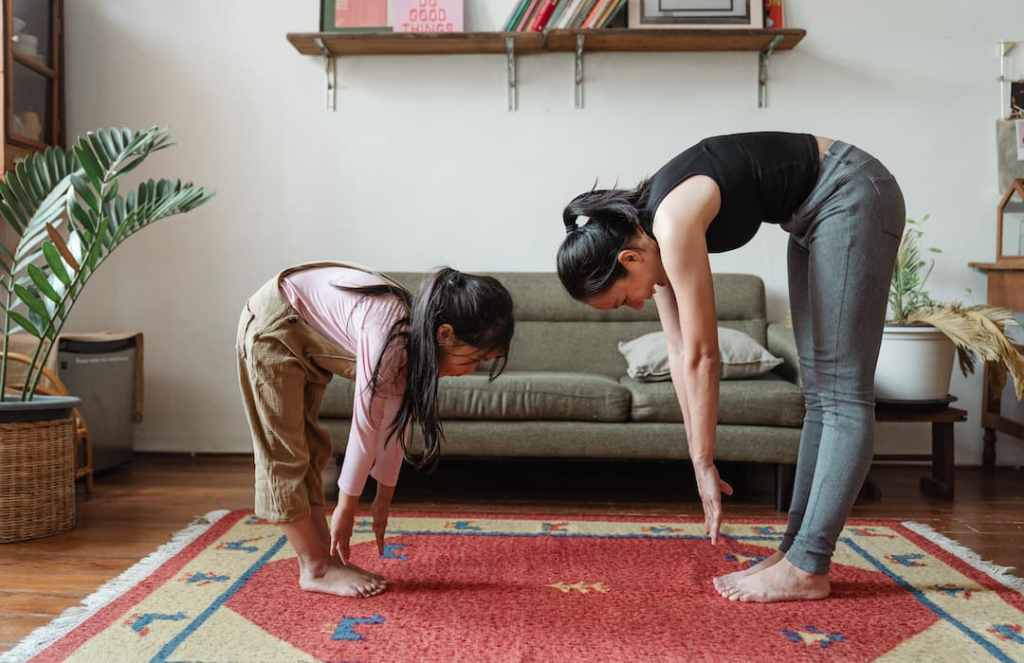

- Yoga is often misunderstood as simply a way of stretching the body. While yoga poses are important, using yoga for anxiety management can be more successful if we see yoga as a multi-dimensional process.
- The word yoga literally means union and was invented as a way to help us balance our inner and external worlds. The proper term, as recorded by Patanjali (200 BCE) is actually Ashtanga yoga, meaning “eight-limbed” yoga.
- The first four limbs are concerned with our external world—the way we react to situations physically, how we handle our personal responsibilities, and whether we notice how often our emotions influence our external actions.
- Once we become more aware of the outside world’s influence on our anxiety, we can start to regulate our thoughts more effectively and explore the higher limbs of ashtanga yoga.
- These higher limbs use different states of meditation—which despite common misunderstandings is actually a form of yoga. Instead of focusing outward, the last four limbs help us reflect on our inner world, learn to recognize anxious thoughts, concentrate on them, and from there, accept their presence.
For those of us in the West, yoga and meditation have never been more popular. It’s now commonplace to have a yoga studio membership, to spend the weekend at a mindfulness retreat, or to follow along as a YouTuber or TikToker guides you through a virtual session. In mental health spaces, both meditation and yoga are now clinically-proven ways to help us manage difficult emotions, specifically anxiety.
But regardless of how widespread they’ve both become, many know surprisingly little about either. As it happens, the poses we’ve all seen are only a small part of a much larger, intuitive process. When we understand yoga as a multi-step pathway, using yoga for anxiety actually makes a lot more sense—and could help you start loosening the hold anxiety may have on your daily life.

Patanjali’s Yoga Sutras: An Ancient Text with Modern Benefits
A short history lesson could help you use yoga stretches for anxiety more successfully. The author of the Yoga Sutras, Patanjali, provided the basis for mindfulness-based therapeutic approaches. Written somewhere around 200 BCE, Patanjali outlines that the purpose of yoga is to bring us closer to the world around us, through an expanded sense of awareness in both body and mind. The Yoga Sutras also explain that meditation is simply another form of yoga, but one that advances inward, rather than outward.
This gradual process is accomplished through ashtanga (meaning eight limbs/steps). Positive change isn’t always pretty, but like stretching a tight muscle, over time, letting go of excess tension becomes easier—but shouldn’t be forced. Yoga aims to gently steer the practitioner toward recognizing the connection between physical and mental spaces, and how their emotional reactions can create positive and negative experiences.
Ashtanga Yoga for Anxiety Management: The First Four Limbs
Ashtanga refers to eight different aspects of your personal experience that can be managed in order to improve your emotional and physical wellbeing. Surprise: You really don’t need to be flexible (or be good at poses) to be a yogi. The eight limbs act as a road map; they aim to steer the practitioner toward a multi-dimensional physical and emotional well-being, like a great linked chain. The first four limbs, as described by Patanjali, are:
1. Yama (restraint): The first limb is all about gently managing our urges—the strong emotional or impulsive thoughts that subtly govern our actions. For example, when we’re hungry, our only concern is finding something to eat. But after we’ve satisfied our hunger, all of our other problems may come rushing back to occupy our minds. Our emotional state can rule each moment of our day and hold us captive, without us really noticing it happening.
We shouldn’t ignore what we feel, because those emotions make us human and create meaning in our lives. Instead, we can remain mindful of how our actions and words may be guided by deeper urges. From there, we can find the healthiest ways to satisfy and moderate our desires—without suppressing them.
2. Niyama (observance): The second limb is about remaining active and responsible in our daily life, keeping ourselves in line with our personal goals (which can be identified with help from a life coach) as best you can. Niyama is somewhat complicated, but in layman’s terms, you’ll focus on being as benevolent as possible to yourself and others.
Niyama is about cultivating a healthy home, work, and social environment—non-judgment, acts of kindness, and devoting time to our hobbies are important parts of this process. You may also begin choosing foods and beverages that don’t upset your digestive system, which plays a huge role in both your physical and mental health. Self-reflection through journaling, walks, personal days and other self-care activities are a core part of niyama.
The other aspect of this second limb includes reflecting on the benefits of being you—taking time when possible to circle what’s going right in your life. Remaining mindful of the people, activities, and goals that you care about can help you use loosen anxiety’s grip on your psyche.
3. Asana (poses): The third limb is probably the most recognizable, because of its popularity in the U.S. Asanas are physical postures that may resemble an animal’s natural stance (like a crane, dog, or cobra), and are used to help relax. But asanas also motivate the practitioner to persevere during times of stress and anxiety. Research shows that when we exert ourselves physically, we may “confront” the difficult life transitions or roadblocks that are weighing on our minds—literally sweating it out.
Since postures are so heavily emphasized in Western culture, understanding the other seven limbs may be more important, and can add meaning to anyone’s yoga practice. But still, people who are struggling with anxiety may discover their mind is unconsciously tightening certain muscle groups, without them even realizing it. Certain anxious thought loops may also become recognizable. Physical discomfort can cause mental distress, which creates more discomfort—and so the cycle continues.
4. Pranayama (breath control): The fourth limb can help us use yoga to manage our anxiety in a subtle, but powerful way. When we’re anxious, there’s evidence to indicate that many of us may hold our breath, or even hyperventilate. Our breathing rhythm is closely tied to our thoughts—which is why pranayama is a way you can use yoga to manage anxiety without even breaking a sweat. Breath control can also help guide us toward a state of meditation, which is why pranayama acts as a key to higher states of consciousness.
Many report feeling frustrated by their initial experiences with yoga and meditation—but many reports have concluded that it doesn’t take long for the mental and physical benefits of this practice to kick in. A 2020 study involving 226 men and women with generalized anxiety found that 54% of them reported significant decreases in anxious thoughts and physical tensions after practicing yoga for a brief period. Experienced practitioners have also been shown to grow new neurons and synapses in their brains that reinforce their cognitive ability to relax, even under pressure.
Ashtanga Yoga for Anxiety Management: The Four Meditation-Based Limbs
The higher limbs focus on what’s typically generalized as meditation, which is where the roots of anxiety may be uncovered. Buddhist monks have had their brains scanned by scientists while absorbed in meditation—they routinely show signs of enhanced brain activity, where regions of the brain that don’t normally work together are functioning as one. The meditation-based limbs of ashtanga yoga for anxiety management, which are:
5. Pratyahara (withdrawal of the senses): The fifth limb of ashtanga might sound a little strange, but once breath control is learned, using yoga for anxiety management takes on a new form. Withdrawing the senses isn’t about ignoring what’s around you. Instead, the fifth limb is about allowing your awareness to fixate on how strong your sense of smell, taste, hearing, sight, and touch actually are.
As you read this article, you may detect the whisper of your breath, the sound of a car rolling by, or the edge of the chair brushing against your leg. Our senses help us experience the world around us, but when we become anxious, the five senses can often become muted, or overblown.
Just acknowledge your body’s tactile awareness, even if there is pain involved. This is an important way to use yoga for anxiety management—as some evidence suggests unbridled anxiety can produce of chronic pain and inflammation. From there, you can accept the sensations you feel like part of your experience; but pain and discomfort don’t define who or what you are as a person.
6. Dharana (concentration): The sixth limb of yoga may be exceptionally helpful for people who struggle to concentrate when they’re feeling anxious. Although this state isn’t often possible to achieve without first getting your breathing and senses under control, once you begin to feel dharana’s sense of concentration welling up inside, there’s really nothing like it. Consider dharana as the initial release from anxiety, as your worries begin to subside.
You’ve probably felt it before—a flow state. Those who paint, enjoy crafts, play sports, instruments, or who have driven or walked for long periods of time have likely passed in and out of a state of dharana without knowing it. Dharana is usually achieved by focusing on an object, task, or emotion until everything else fades away. Maybe you have a song’s melody stuck in your head, a sentimental item, a person whom you love, or a pet you adore. Focus on that “thing.” As your breathing becomes balanced and any tightness in your chest fades away, you might start feeling the benefits of using yoga for anxiety management.
7. Dhyana (contemplation): Once you’ve passed through the other six limbs, you may find it easier to begin experiencing the seventh limb—contemplation. Though in the West we usually confuse meditation with having an empty mind (which can make meditating an elusive, frustrating process), dhyana, or meditation, isn’t about clearing your head, so much as it is accepting that it can’t ever be completely empty. Read that sentence again!
In true dhyana, you may see that there’s actually power in submitting to your anxiety—by accepting its presence—and knowing that it can’t possibly define you, touch you, or overwhelm your senses. We can’t solve our overthinking by overthinking. But this will cause you to fall out of your state of dharana (concentration), making dhyana (meditation) impossible.
You will always feel something, and meditation is about letting those inner feelings wash over you, not resisting them. In dhyana, the seventh limb, we are aware that endless thoughts come and go—like water rushing along the bottom of a deep riverbed. Some times the surface is clear and tranquil, and at others, the banks are flooded.
In this state, it’s encouraged to practice empathy for yourself. Acknowledge the pain that anxiety has caused you—only then can you loosen its grip.
8. Samadhi (total absorption): If dhyana allows you to notice the constant stream of thoughts, the final and eighth limb, samadhi, involves total absorption. Using the metaphor of a river once more, the thoughts you experience create a current. Anxiety can cause the current to overflow its banks, creating an imbalance. So Instead of identifying with the thoughts that rush through your mind like water, samadhi identifies our mind and body with the river itself. Leaving its mark, ever-changing, constantly shaping and being shaped by the world, inside and out.
Samadhi steers us toward the same goal as many modern counseling methods, including cognitive behavioral therapy (CBT), dialectal behavioral therapy (DBT), solution-focused brief therapy—for each of us to recognize in our own way that the only thing we can truly control is how we respond to what we experience. Through the eighth limb, the toxic clutter of our anxious thoughts is free to flow past us, until we become absorbed and purified in the running water.
Samadhi allows us to recognize the emotional independence we’ve always been capable of, and to appreciate the delicate tethers we share with the landscapes, people, animals, and situations around us. That’s why it’s an integral part of using yoga for anxiety management, whether you use ashtanga yoga, or a mindfulness-based therapist.
So the next time you need some extra strength to get a grip on your anxiety, and two hands just aren’t enough—try using eight.
















